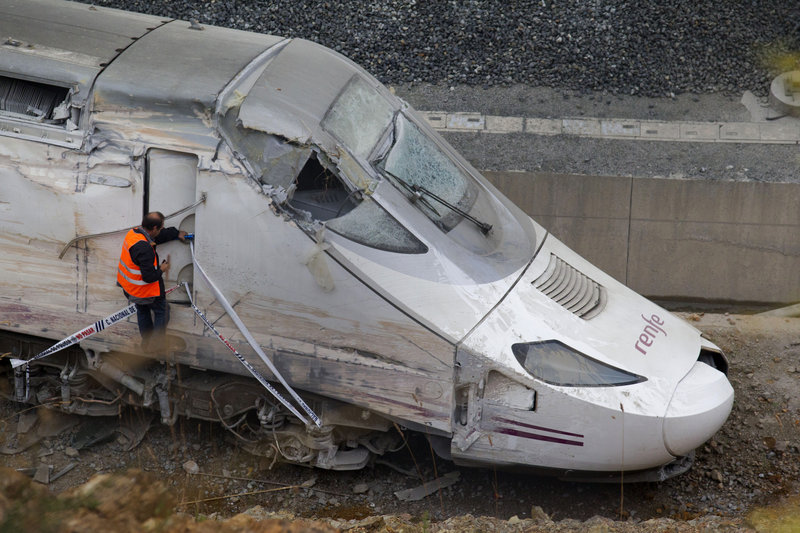MADRID — The driver was on the phone with a colleague and apparently looking at a document as his train barreled ahead at 95 mph – almost twice the speed limit. Suddenly, a notorious curve was upon him.
He hit the brakes too late. The train, carrying 218 passengers in eight carriages, hurtled off the tracks and slammed into a concrete wall, killing 79 people.
On Tuesday, investigators looking into the crash announced their preliminary findings from analysis of the train’s data-recording “black boxes,” suggesting that human error appears to be the cause of Spain’s worst railway disaster in decades.
The derailment occurred near Santiago de Compostela, a city in northwestern Spain, late last Wednesday. Some 66 people injured in the crash are still hospitalized, 15 of them in critical condition.
According to the investigation so far, train driver Francisco Jose Garzon Amo received a call from an official of national rail company Renfe on his work phone in the cabin, not his personal cellphone, to tell him what approach to take toward his final destination.
The Renfe employee on the telephone “appears to be a controller,” a person who organizes train traffic across the rail network, said a statement from a court in Santiago de Compostela, where the investigation is based.
“From the contents of the conversation and from the background noise it seems that the driver (was) consulting a plan or similar paper document.”
The statement on the preliminary findings did not indicate whether such a phone conversation is common between a driver of a moving train and a controller, and it did not say how long the call lasted. It did not name the Renfe official who called the driver, nor did it further describe what plan or document the driver was consulting.
The train had been going as fast as 119 mph shortly before the derailment, and the driver activated the brakes “seconds before the crash,” according to the statement. The speed limit on the section of track where the crash happened was 50 mph.
Authorities have said that a high-tech automatic braking program called the European Rail Traffic Management System was installed on most of the high-speed track leading from Madrid north to Santiago de Compostela – the route Garzon’s train took. But the cutting-edge coverage stops just three miles south of where the crash occurred, placing a greater burden on the driver to take charge.
The Spanish rail company has said the brakes should have been applied 2.5 miles before the train hit the curve.
Send questions/comments to the editors.



Success. Please wait for the page to reload. If the page does not reload within 5 seconds, please refresh the page.
Enter your email and password to access comments.
Hi, to comment on stories you must . This profile is in addition to your subscription and website login.
Already have a commenting profile? .
Invalid username/password.
Please check your email to confirm and complete your registration.
Only subscribers are eligible to post comments. Please subscribe or login first for digital access. Here’s why.
Use the form below to reset your password. When you've submitted your account email, we will send an email with a reset code.